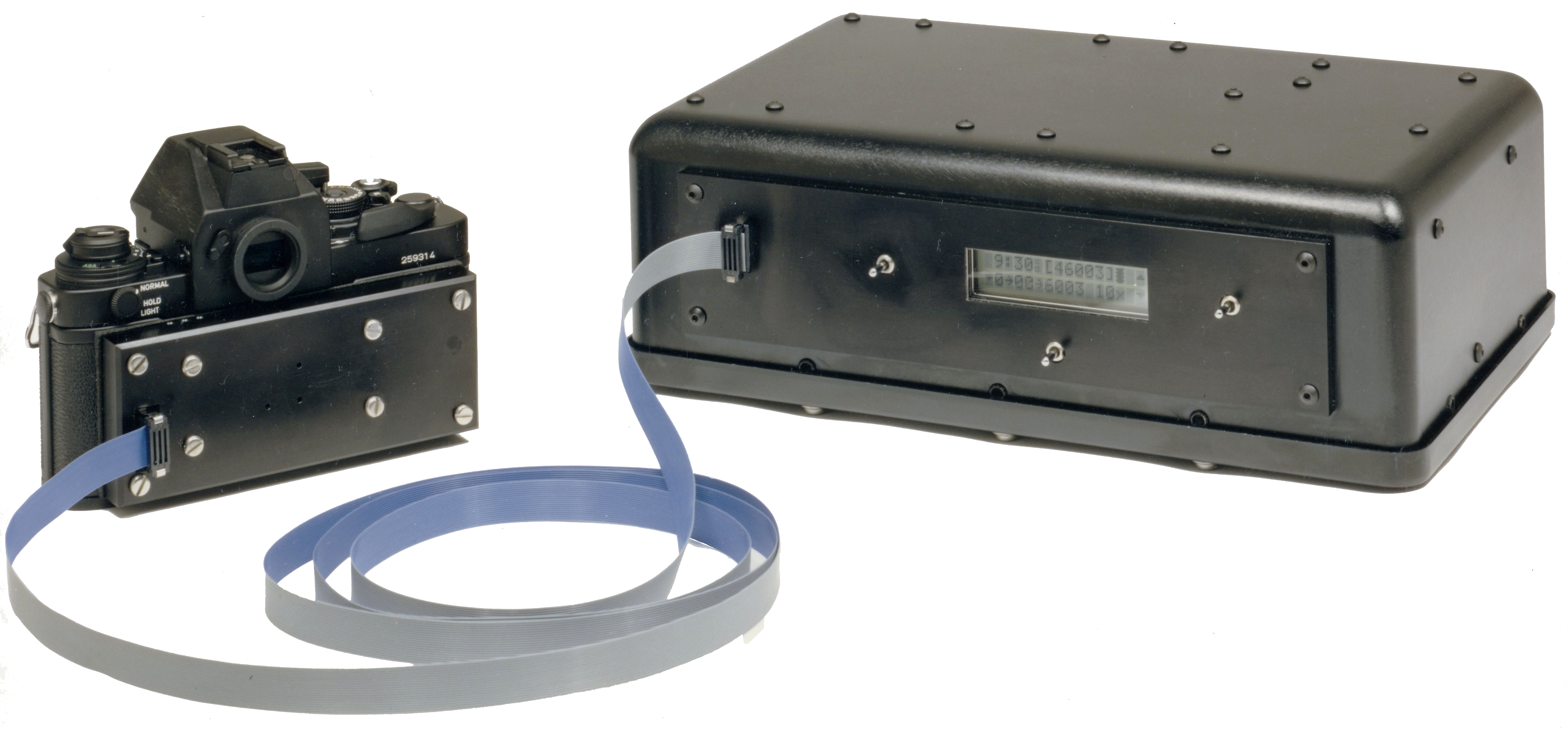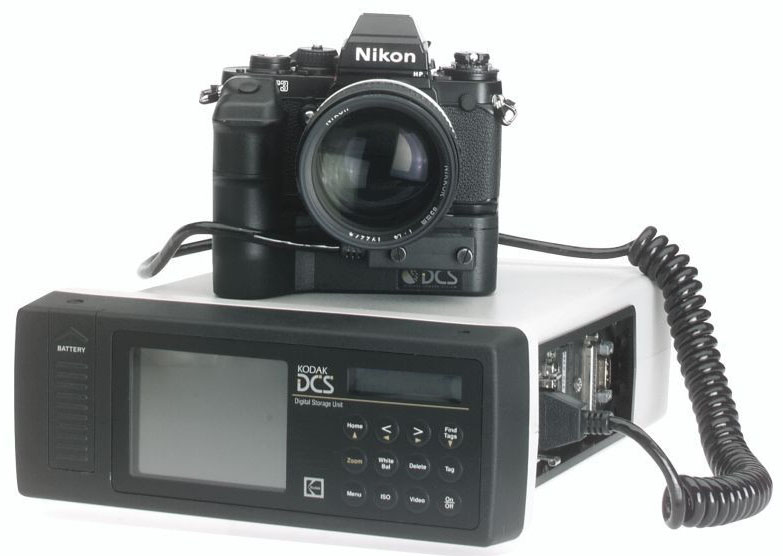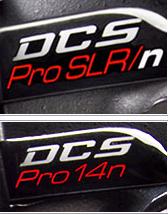|
Kodak DCS cameras based on Nikon |
|
Kodak DCS cameras based on Nikon |
|
1988 Kodak Electro-Optic Camera |
1989 Kodak HawkEye II |
1989 Kodak HawkEye II |
1991 Kodak DCS 100 |
1992 Kodak DCS 200 |
1992 Kodak DCS 200 |
|
1992 Kodak DCS 2000 |
1994 Kodak DCS 420 |
1994 Kodak DCS 460 |
1996 Kodak DCS 410 |
1996 Kodak DCS 425c/425ir |
1998 Kodak DCS 315 |
|
1998 Kodak DCS 330 |
1999 Kodak DCS 620 |
1999 Kodak DCS 660 |
2001 Kodak DCS 720x |
2001 Kodak DCS 760 |
2003 Kodak DCS 760M |
|
2002 Kodak DCS 14n |
2004 Kodak DCS SLR/n |
|
the first digital still camera of the World |
In 1975, Steve Sasson, an engineer of Kodak Corp. invented the first digital still camera which use a Fairchild CCD of 100 x 100 pixels, 16 batteries, cassette tape for storage. You can find here an History of Kodak Professional DCS. |

Kodak Electro-Optic Camera
Since 1987, Kodak had developed the world's first megapixel CCD imager, the M1. It was used on the prototype Electro-Optic Camera based on a Nikon F3.
|
prototype Hawkeye II |
prototype Hawkeye II digital back |
Hawkeye II focusing screen |
Kodak HawkEye II Integrated Imaging Accessory |
Kodak HawkEye II Integrated Imaging Accessory back |
Then on the IRIS and Hawkeye II bodies built on the basis of the Nikon F3HP. A "compact" version of the Hawkeye II was developed.
The Kodak Hawkeye II was used by NASA.

Kodak DCS 100
Kodak launched in 1991 its first digital system the DCS (Digital Camera System), later called the DCS 100. It is based on the Nikon F3 body with a special
focusing screen and a specific motor drive. This motor allows 2,5 images per second.
The focusing screen is marked out to show the field of view of the CCD 16 x 21 mm and the areas (in gray) around. This focusing screen gives a small picture in the viewfinder but
allows anticipating on what is going or coming in the viewfinder.
The relative sensitivity of DCS 100 is 100 ISO.
The CCD inside DCS 100 is a 1.3 megapixel CCD (1024 x 1280 pixels) which measures 20.5 x 16.4mm. To obtain the equivalent focal length in 24x36, it is necessary to
divide the focal by 1,8. A 28 mm with DCS 100 is equivalent to a 50 mm in 24x36.
Images are stored in a DSU (Digital Storage Unites); this unit weights 5 kg and is connected by a 2m cable to DCS 100. The DSU contains 200 Meg and can store from 150 to 600
pictures. It has a built-in 4" LCD monochrome monitor screen, SCSI Interface, optional keyboard, 12 volts charger and sized 5 kg.
A color version (DC 3) and a white and black (DM 3) versions of DCS 100 were available. The initial sale price was £15,000.
DCS 200, in sale from 1992 to 1994, is based on a Nikon N8008s. It is a totality compact without cable and weights 1,7 kg The N8008s body is completed a high grip, developed by Kodak. This architecture: special grip (or back) added to a classic body will be used in next DCS cameras. The main part of DCS 200 is a new CCD chip of 1,54 Meg (1524 x 1012 pixels) on 8 bits for an array of 14 x 9.3mm. The DCS 200 CCD is more efficient and smaller than the CCD chip of DCS 100. The size of the picture in viewfinder of DCS 200 is near of the size of 24x36 and to obtain the equivalent focal length in 24x36, it is necessary to divide the focal by 2,5. A 28 m with DCS 200 is equivalent to a 70 mm in 24x36.
|
|
|
|
There are six variants of the DCS200: DCS 200 ci (color and integrated hard disk), DCS 200 c (color without internal hard disk), DCS 200 mi (black and white and integrated hard disk), DCS 200 m (black and white without internal hard disk), DCS 200 IR (infrared sold $16,000, Kodak only made about 50 or so ) and the 'Wheelcam' (color by a triple green red and blue exposures).
The built-in 80 megabyte hard disk can store fifty pictures; each picture needs 4,5 Meg. To visualize pictures taken, it is necessary to unload the content of the hard disk on a microcomputer via the integrated SCSI interface. DCS 200 does not comprise integrated LCD monitor screen. It is possible to take a picture every 2,5 seconds. Batteries allow to take a hundred of pictures.
The initial sale price was £ 7000.
|
1.54 megapixel chip of DCS 200 |
|
DCS 4xx image size |
In 1992, The DCS 200 High Speed Target Camera is a seventh version of DCS 200 and probably the first mirror-less digital camera with interchangeable lenses.
|
DCS 200 High Speed Target Camera |
The Kodak DCS-200 High Speed Target Camera is especially designed for Theme Park Rides.
The camera is outfitted with a high reliability shutter on the front.
The exposure is made by flash so shutter times is not that important.
These cameras are installed in Theme Park rides and are to take pictures of people at the critical point where the car is falling. They are stationary mounted and suppose to last a long, long time without failure, shooting literally thousands of pictures per day. The pictures are then wired or downloaded to the Gift Shop where they are displayed on monitors and visitors can buy a thermal copy of their ride. |
back of DCS 200 High Speed Target Camera |
|
DCS 2000 (NC2000) |
In 1994 Kodak develops for Associated Press an "Associated New Press Camera", called NC 2000. This camera uses the same CCD chip that DCS 100 but color filtration of the CCD elements was issued from DCS 220. It is built from the Nikon N90 with a correction coefficient of 1 ,65. This camera can store images on hard disk or card PCCard Type III, can take 6 images at 2,5 images by second and cost $14,500 (nearly $30,000 in 2021's dollar). There is existing one other variant of the NC2000 : the NC 2000 E, which is built from the Nikon N90s with a correction coefficient of 2,5. This camera has
the same CCD as the DCS 100 (1268x1012 Pix, 21x16 mm, 1,3 Mpix CCD) and also a SCSI connection. |
DCS 420 has replaced DCS 200 in 1994. It has the same one-bloc architecture and is based on a Nikon N90X. It possesses equally the same CCD chip that DCS 200.
Pictures are recorded on a card PCCard (called also PCMCIA card) which is installed on the side of the camera body.
|
|
The interchangeable card has a capacity of 105 Meg and can store 64 images, it can be replaced by cards of more important capacity, 130 Meg or more. this feature is a good improvement in regard of DCS 200. The internal memory of 8Mb allows to take images in 2.25 seconds before the recording on the PCCard. It is possible to record an vocal annotation with pictures. |
1,54 Megapixels CCD chip |
There are existing three versions of the DCS420: DCS 420 c (color), DCS 420 m (black and white), DCS 420 ir (infrared). The initial sale price of DCS 420 was £ 8000.
In 1995, DCS 460 uses the same design that DCS 420 but integrates a fabulous CCD chip of 6 millions of pixels, a record again today. This CCD chip of 6,230,160 pixels (2036 x3060 pixels) is the record today. The array is 28mm on 19 mm that implies that to obtain the focal equal in 24x36, it is necessary to multiply the focal by 1,28. It is the first camera allowing the use of fish-eye and great angle. Images make 18 Megs and are coded on 12 bits.
|
|
It can take 2 images all 8 seconds. |
|
|
US Navy SEAL with Kodak DCS 425 photo by Ted Banks. |
|
In 1996, Kodak develops for the US NAVY commandos, the SEALS, some DCS based on the underwater reflex camera of Nikon: the Nikonos RS. |
DCS 410 is recognizable by its red Kodak logo on its handle. It has been commercialized from 1996 to 1998. It has a 1.5 millions of pixels CCD chip (1012 x 1524) and can work only image by image. It is available only in color version.
|
|
In 1998, Kodak presents new camera DCS 315 that is designed from the Nikon Pronea 6i. This camera has a 1,5 Million of pixels CCD chip,
stores pictures on a PCCard. |
|
The APS format is smaller than 24x36 and allows a correction coefficient of only 1,7 with the same CCD chip that the DCS420 chip (1, 5 Meg or 1012 x 1524 pixels). It contains a processor Motorola 821 PowerPC to manage transfer and storage operations. Images make 4,5 Meg. The back of the machine has a color monitor screen of 4,5 cm. This camera has also a built-in flash. The storage is on card PCCard. DCS 315 has a FireWire output (IEEE 1394) and allows 2 images by second during 3 images.
|
|
Launched in 1998, DCS 330, built also on Nikon Pronea 6i, has for main part a new CCD chip of 3 millions of pixels (2008 x 1504 pixels). DCS 330 has a flash synchronization speed of 1/180s. The correction coefficient is 1,9. |
DCS 620 and DCS 660 are commercialized in 1999 and are based on the Nikon F5. The body of the F5 has been slightly heightened to contain the electronics.
DCS 620 has a CCD chip of 2 millions of pixels, a double support for PCCard (PCMCIA) Type II, III, a battery with an autonomy of 300 images, a monitor color screen
(1.8-inch) integrated to the back, an interface IEEE 1394.
In 2000, a new version of the DCS 620 Digital Camera, the DCS 620x , allows an High ISO range, from 400 to 6400. It has also an higher color saturation, a direct
mobile phone transmission option, a full image viewfinder WYSIWYG and an internal microphone for recording. The others characteristics are the same as DCS 620.
|
|
|
DCS 660 is identical but has a CCD chip of 6 millions of pixels.
To note that Kodak has developed models built on Canon EOS1 body and equivalent to DCS 620 and 660: DCS 520 and 560.
|
Showed in 2001, the DCS 760 is a updated release of DCS 660. It has a new Kodak CCD of 6.3 megapixel (picture 2.008 x 3.032 pixels) and a 128 Meg internal
memory that allows to shoot at 1,5 frames/second on 24 following pictures. |
|
İEastman Kodak Company, 2001 |
At PMA 2002, Kodak presents a new camera the DCS 760M which is designed to deliver black and white pictures only. |
|
|
|
|
Kodak has announced in Photokina 2002 the DCS14n , a new 14 megapixel camera completely designed and built by Kodak.
This digital SLR has a 13.89 megapixel CMOS sensor which is full frame 24 x 36 mm (as Canon 1DS). The magnesium-alloy body is designed as the Nikon N80 but has
possibilities of N100/N80. It is rather smaller than any previous Kodak DCS camera.
This camera has a Lithium-Ion battery, storage by Compact Flash (Type I/II) and SD/MMC, it supports RAW and JPEG format and also a new JPEG-ERI (higher dynamic range JPEG)
format. It has also an internal upgradeable buffer and an orientation sensor.
The camera should be available in December 2002 with a sell price of US$4,000.
 |
At PMA 2004, Kodak presents the DCS SLR/n. It is based on the DCS 14n
(on the Nikon N80 for internals and top) but offers numerous improvements including a redesigned sensor. |
 |
pierre j.